
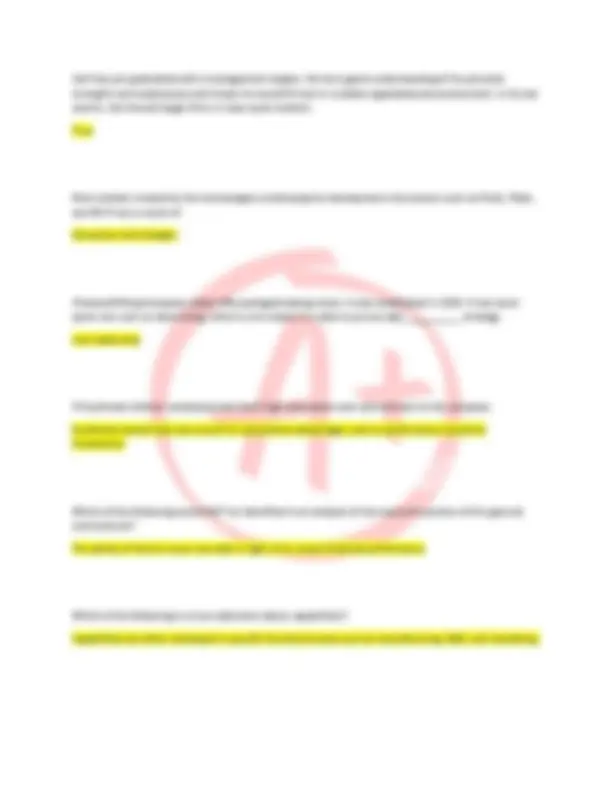
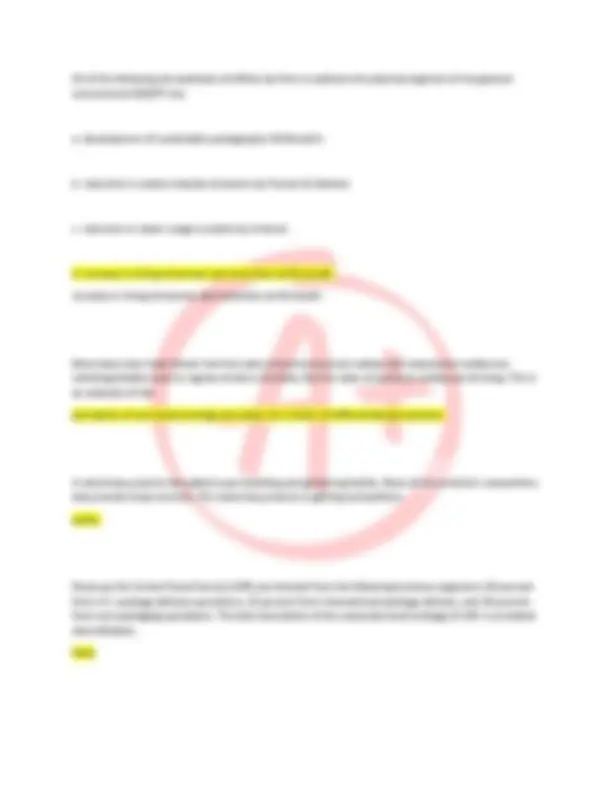
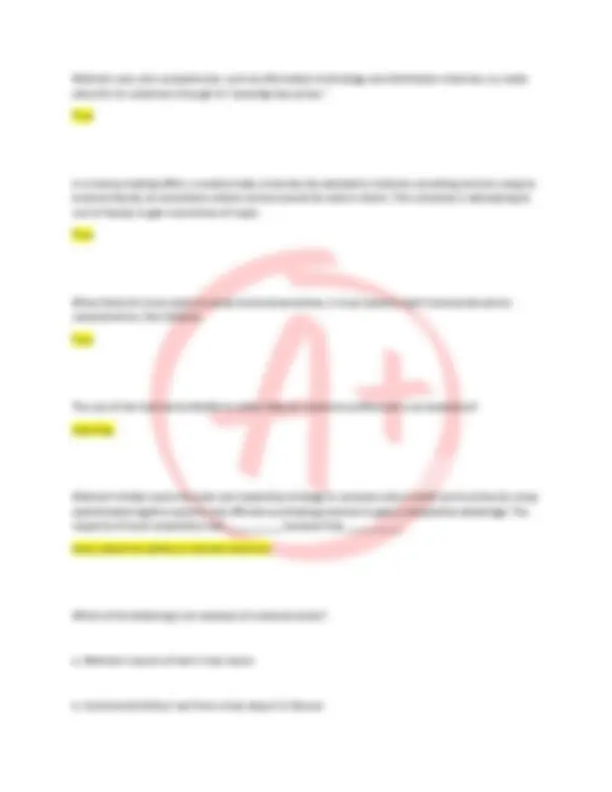
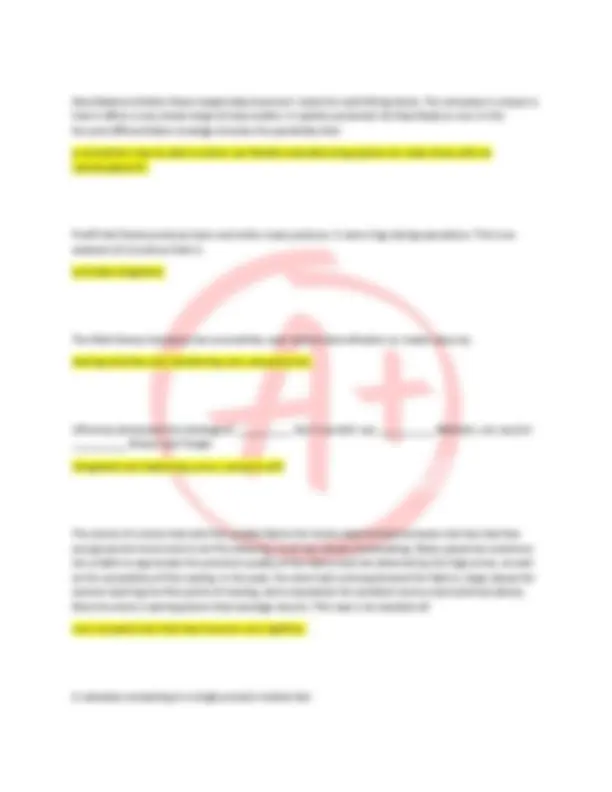
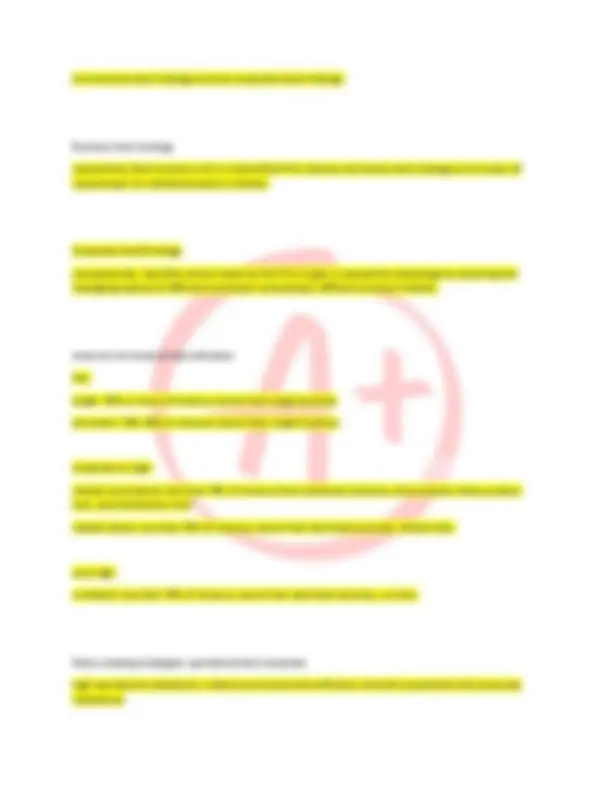







Study with the several resources on Docsity

Earn points by helping other students or get them with a premium plan


Prepare for your exams
Study with the several resources on Docsity

Earn points to download
Earn points by helping other students or get them with a premium plan
Community
Ask the community for help and clear up your study doubts
Discover the best universities in your country according to Docsity users
Free resources
Download our free guides on studying techniques, anxiety management strategies, and thesis advice from Docsity tutors
GCU BUS-485 Midterm Real Exam (Questions With Verified Answers ) ALREAY GRADED A+
Typology: Exams
1 / 18

This page cannot be seen from the preview
Don't miss anything!











Southwest Airlines' tightly integrated activities make its cost leadership strategy more vulnerable to imitation than if its activities were loosely integrated. False The new CEO of Opacity Enterprises is determined to make the long-established firm strategically flexible. The CEO should understand that the task is not easy, largely because of inertia that can build up over time. True Walmart's change in strategy to attract more upscale customers will likely succeed because cost leaders are good at differentiating. False An interior decorator has moved his business from Los Angeles to St. Paul, Minnesota, because his spouse's company transferred her to St. Paul. The decorator is distressed because the customers in his target market have, in his words, "banal and bourgeois taste." Which of the following is the decorator's problem? The decorator does not understand that customer needs are neither right nor wrong, and neither good nor bad. A major department store chain has a strict policy of banning photographs or videos of its sales floor or back-room operations. It also does not allow academics to conduct studies of it for publication in research journals. In fact, some of its own top managers refer to the management's policies on secrecy
as "verging on paranoid." These policies indicate that the top management of the firm believes the organization's core competencies are: imitable. Consolidation among fuel providers serving airport facilities is viewed in the five forces model of competition as a(n): increase in the bargaining power of suppliers of a critical input. The Department of Defense buys aircraft from U.S. companies for national security reasons. This is an example of a __________ barrier to entry. government policy Two firms, such as a small local, family-owned Italian restaurant and Olive Garden, share few markets and have little similarity in resources, but are nonetheless direct and mutually acknowledged competitors. False Boeing's decision to commit the resources required to build the super-efficient 787 midsized jetliner is an example of a tactical action. False It is more likely that locally owned, one-location cafes in a small town will respond more rapidly to tactical actions by each other than they will to strategic actions by the Burger King franchise that has recently moved to their town. True
All of the following are examples of efforts by firms to address the physical segment of the general environment EXCEPT the: a. development of sustainable packaging by McDonald's. b. reduction in carbon dioxide emissions by Procter & Gamble. c. reduction in water usage in plants by Unilever. d. increase in hiring of women and minorities at Microsoft. increase in hiring of women and minorities at Microsoft. Blind taste-tests have shown that the taste of premium-priced vodkas and inexpensive vodkas are indistinguishable even to regular drinkers of vodka. But the sales of premium vodkas are thriving. This is an example of the: perception of perceived prestige and status as a means of differentiating a product. A veterinary practice has added a pet boarding and grooming facility. Most of the practice's competitors also provide these services. The veterinary practice is gaining competitive: parity. Revenues for United Parcel Service (UPS) are derived from the following business segments: 60 percent from U.S. package delivery operations, 22 percent from international package delivery, and 18 percent from non-packaging operations. The best description of the corporate-level strategy of UPS is unrelated diversification. False
Walmart uses core competencies, such as information technology and distribution channels, to create value for its customers through its "everyday low prices." True In a money-making effort, a small private university has decided to institute consulting services using its business faculty as consultants whose services would be sold to clients. This university is attempting to use its faculty to gain economies of scope. True When Delta Air Lines wants to study Continental Airlines, it must examine both Continental and its complementor, Star Alliance. True The use of the Internet by Netflix to collect data on customer preferences is an example of: scanning. Walmart initially used a focused cost leadership strategy to compete only in small communities by using sophisticated logistics systems and efficient purchasing practices to gain a competitive advantage. The response of local competitors was __________ because they __________. slow; lacked the ability to marshal resources Which of the following is an example of a tactical action? a. Walmart's launch of Sam's Club stores b. Continental Airlines' exit from a hub airport in Denver
Which of the following statements is true? a. Conglomerates no longer exist in the U.S. business scene, but are common in emerging markets. b. Unrelated diversified firms seek to create value through economies of scope. c. The sharing of intangible resources, such as know-how, between firms is a type of operational sharing in related diversifications. d. Related constrained firms share more tangible resources and activities between businesses than do related linked firms. Related constrained firms share more tangible resources and activities between businesses than do related linked firms. Greenleaf Property Management has been earning below-average returns for the last three years. Which of the following statements is true? a. Greenleaf will be able to satisfy its multiple stakeholders easily as long as the stakeholders are committed to the strategic mission of the firm. b. Greenleaf will be able to minimally satisfy the demands of each stakeholder. c. Greenleaf will need to prioritize the demands of its stakeholders based on the political influence each wields. d. Greenleaf will not be able to minimally satisfy all stakeholders. Greenleaf will not be able to minimally satisfy all stakeholders.
New Balance Athletic Shoes target baby boomers' needs for well-fitting shoes. The company is unique in that it offers a very broad range of shoe widths. A realistic potential risk New Balance runs in this focused differentiation strategy includes the possibility that: a competitor may be able to better use flexible manufacturing systems to make shoes with an individualized fit. PorkPride Foods produces hams and other meat products. It owns hog raising operations. This is an example of a business that is: vertically integrated. The Walt Disney Company has successfully used related diversification to create value by: sharing activities and transferring core competencies. JCPenney attempted the strategy of __________. But it couldn't out __________ Walmart, nor could it __________ Macy's and Target. integrated cost leadership; price; compete with The owner of a store that sells fine-quality fabrics for home seamstresses bemoans the fact that few young women know how to do fine tailoring, much less simple dressmaking. Many potential customers are unable to appreciate the premium quality of the fabrics and are deterred by the high prices, as well as the complexity of fine sewing. In the past, the store had a strong demand for fabrics, large classes for women learning the fine points of sewing, and a reputation for excellent service and technical advice. Now the store is earning lower-than-average returns. This case is an example of: core competencies that have become core rigidities. A company competing in a single product market has:
low operational relatedness: unrelated diversification and related linked diversification Operational Relatedness sharing activities between businesses Corporate Relatedness transferring core competencies into businesses economies of scope Cost savings that occur when a firm transfers capabilities and competencies developed in one of its businesses to another of its businesses. multimarket competition Firms competing against each other in several product or geographic markets. Competitive Dynamics The total set of actions and responses taken by all firms competing within a market Competitive Rivalry Ongoing actions and responses taking place between an individual firm and its competitors for advantageous market position
business-level strategy defined An integrated and coordinated set of commitments and actions the firm uses to gain a competitive advantage by exploiting core competencies in specific product markets. Core competencies Resources and superior capabilities that are sources of competitive advantage over a firm's rivals strategy An integrated and coordinated set of actions taken to exploit core competencies and gain competitive advantage To position itself, the firm must decide whether it intends to
resources, capabilities, core competencies, discovering core competencies (4 criteria of sustainable advantages and value chain analysis), competitive advantage, and strategic competitiveness what are the 4 criteria of sustainable advantages valuable, rare, costly to imitate, non substitutable part of value chain analysis outsourcing conditions affecting managerial decisions uncertainty, complexity, and intraorganizational conflicts. tangible resources financial, organizational, physical, technological financial resources
physical resources sophistication of a firm's plant and equipment and the attractiveness of its location, distribution facilities, product inventory technological resources Availability of technology-related resources such as copyrights, patents, trademarks, and trade secrets intangible resources human, innovation, reputation human resources knowledge, trust, skills, abilities to collaborate with others innovative resources ideas, scientific capabilities, capacity to innovate Reputational Resources Brand name Perceptions of product quality, durability, and reliability Positive reputation with stakeholders such as suppliers and customers historical (Costly-to-imitate capabilities) unique and valuable organizational culture or brand name
Porter's Five Forces (industry environment) threat of entry, threat of substitute, supplier power, buyer power, and competitive rivalry Parts of the External Environment Analysis scanning, monitoring, forecasting, assessing scanning identifying early signals of environmental changes and trends monitoring detecting meaning through ongoing observations of environmental changes and trends forecasting Developing projections of anticipated outcomes based on monitored changes and trends assessing Determining the timing and importance of environmental changes and trends for firms' strategies and their management attractive industry high entry barriers, suppliers and buyers have weak positions, few threats from substitute products, moderate rivalry among competitors
Unattractive Industry low entry barriers, suppliers and buyers have strong positions, strong threats from substitute products, intense rivalry among competitors competitor analysis components